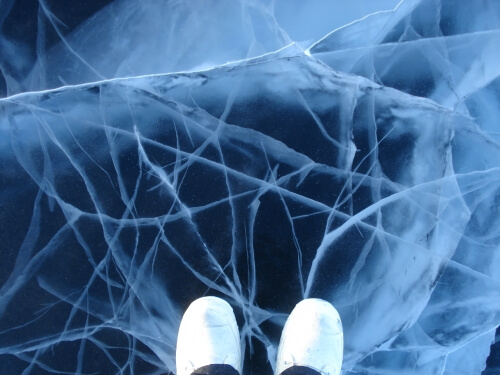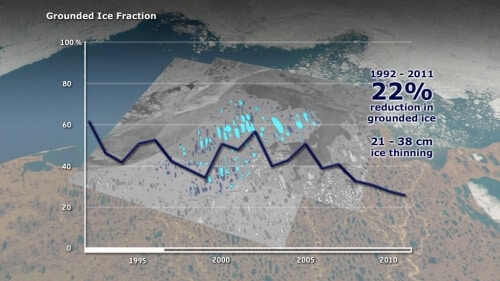Researchers from Canada who examined satellite images from the European Space Agency and data from ground measuring stations found that the lakes in northern Alaska begin to freeze 6 days later and thaw 18 days earlier in 2011 than in 1950

Lakes in the Arctic region freeze later and thaw earlier, creating a shorter winter season than in 1950. This is according to a study by the University of Waterloo in Canada.
The study, funded by the European Space Agency (ESA) and published in the journal cryosphere also reveals that climate change dramatically affects the thickness of the ice covering the lakes during the coldest period of the season in 2011. The Arctic lake ice was thinner on average by 38 centimeters compared to the reference year.
"We discovered that the thickness of the ice has decreased greatly in response to climate warming in the region," said the lead author of the article Christina Sorto, a doctoral student of Prof. Claude Dugas in the Department of Geography and Environmental Management at the University of Waterloo. . "When we saw the actual numbers we were shocked at how dramatic the change was."
The researchers examined over 400 lakes on the north coast of Alaska, and for the first time were able to document the magnitude of the change in ice lake in the region over such a long period of time.
"Before starting our analysis, we expected to find a decrease in the thickness of ice covering the lake and the amount of ice on the bottom of the lakes based on the temperature and precipitation records of the last five decades from the meteorological stations in the area," Sordo said. But at the end of the analysis, when we looked at the trends, we were shocked when we discovered that the dramatic decrease in the amount of ice occurred in the last 20 years."
The research team members used radar images from European Space Agency satellites and determined that 62% of the lakes in the region were frozen to the bottom in 1992. In 2011, only 26% of the lakes were frozen to the bottom of the lake. Overall, there was a 22 percent decrease in what researchers call "grounded ice" 1992-2011.
The researchers were able to distinguish the difference between a lake that was not completely frozen to the bottom and a frozen lake until the crack, because the satellite radar signals behaved very differently, depending on the presence or absence of water under the ice.

Radar signals are absorbed into the sediment below the lake, when it is frozen to the bottom. However, when there is water under the ice with bubbles, the beam bounces back sharply towards the radar system. Therefore, completely frozen lakes appear very dark in satellite images, while those that are not frozen to the bottom appear clear.
For information on the University of Waterloo website
Researchers used the Canadian Ice Model (CLIMo) to estimate ice cover and thickness in lakes prior to 1991, where no satellite images were available. The model simulations show that lakes in the region froze nearly six days later and thawed 18 days earlier in the winter of 2011 compared to the winter of 1950. Shorter seasons of ice cover may lead to changes in algae productivity and thawing of the frozen soil beneath the lake bottom.
"The changes in the ice and the shortening of the winter are affecting the northern communities that depend on ice roads to transport goods," Sordo said. The dramatic changes in lake ice may also contribute to further warming of the entire region because the open water in the lakes contributes to warmer air temperatures, although to a lesser extent than open sea water."

9 תגובות
I agree with you Yair .. it's just supporting evidence .. show me a graph .. any graph in the economy and I can find two points twice .. one that will show that there is an upward trend and the other that there is a decrease ... it's all a question of where you check at all.
In 1970 there was a cooling trend in general...and if they had measured they would have found that more ice existed than in 1950...but in 2011 not.
And it's so fun to hear how you Nisim call stupid people without any proof in hand...why?? ..so dark..because they told me you are on a science website. Do you have something scientific to contradict what he said (because his article was really long), rather... let's have a discussion
right….
OK, I didn't claim otherwise. This is simply the title "more proof of warming", and I claim that it is not.
Yair B.E
There is no evidence in science. But there is definitely "there is evidence beyond any doubt". And that's the case with warming.
This is not "proof" of global warming. It is merely a support, reinforcement or exemplary testimony.
Amit
Gabi Avital is an idiot in so many areas...
Do not confuse the facts with Gabi Avital, the supreme authority on the subject:
http://www.israelhayom.co.il/article/152109
And with us, winter was shortened to one week in December and another week in Purim and that's it.